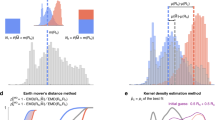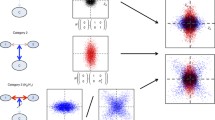Abstract
Schizophrenia is a frequent and devastating disorder beginning in early adulthood. Until now, the heterogeneity of this disease has been a major pitfall for identifying the aetiological, genetic or environmental factors. Age at onset or several other quantitative variables could allow for categorizing more homogeneous subgroups of patients, although there is little information on which are the boundaries for such categories. The Bayesian networks classifier approach is one of the most popular formalisms for reasoning under uncertainty. We used this approach to determine the best cut-off point for three continuous variables (i.e. age at onset of schizophrenia and neurological soft signs) with a minimal loss of information, using a data set including genotypes of selected candidate genes for schizophrenia.
Preview
Unable to display preview. Download preview PDF.
Similar content being viewed by others
References
Mueser, K.T., McGurk, S.R.: Schizophrenia. Lancet 363, 63–72 (2004)
McClure, R.K., Lieberman, J.A.: Neurodevelopmental and neurodegenerative hypotheses of schizophrenia: a review and a critique. Curr. Opin. Psychiatry 16(suppl. 2), S15–S28 (2003)
Gottesman, I.I.: Schizophrenia Genesis. W.H.Freeman, New York (1991)
Torrey, E.F.: Are we overestimating the genetic contribution to schizophrenia? Schizophr. Bull. 18, 159–170 (1992)
McGuffin, P., et al.: Genetic basis of schizophrenia. Lancet 346, 678–682 (1995)
Ouali, A., et al.: Phenotype Analysis in Schizophrenia using Neural Networks. In: IASTED International Conference on B-E, Innsbruck, Austria, February 16-18 (2005)
Krebs, et al.: Validation and factorial structure of a standardized neurological examination assessing NSS in schizophrenia. Elsevier Schizophrenia Research 45, 245–260 (2000)
Gourion, D., et al.: Minor physical anomalies in patients with schizophrenia and their parents. Psychiatry Research 125(1), 21–28 (2004)
Gourion, D., et al.: Neurological and morphological anomalies and the genetic liability to schizophrenia: a composite phenotype. Schizophrenia Res. 67, 23–31 (2004)
Crocq, M.A., Mant, R., et al.: Association between schizophrenia and homozygosity at the dopamine D3 receptor gene. J. Med. Genet. 29, 858–860 (1992)
Krebs, M.O., et al.: Brain derived neurotrophic factor (BDNF) gene variants association with age at onset and therapeutic response in schizophrenia. Mol. Psychiatry 5, 558–562 (2000)
McCallum, A., Nigam, K.: A comparison of event models for naive bayes text classification. In: AAAI 1998 Workshop on Learning for Text Categorization (1998)
Lewis, D.: Naive (bayes) at forty: The independence assumption in information retrieval. In: Tenth European Conference on Machine Learning (1998)
Yang, Y., Chute, C.G.: An example-based mapping method for text categorization and retrieval. ACM Transactions on Information Systems 12(3) (1994)
Domingos, P., Pazzani, M.: Beyond independence: conditions for the optimality of the simple Bayesian classifier. In: Proceedings of the Thirteenth International Conference on Machine Learning, pp. 105–112. Morgan Kaufman Publishers, San Francisco (1996)
Author information
Authors and Affiliations
Editor information
Editors and Affiliations
Rights and permissions
Copyright information
© 2005 Springer-Verlag Berlin Heidelberg
About this paper
Cite this paper
Ouali, A., Cherif, A.R., Krebs, MO. (2005). The Use of Bayesian Networks for Subgrouping Heterogeneous Diseases. In: Cabestany, J., Prieto, A., Sandoval, F. (eds) Computational Intelligence and Bioinspired Systems. IWANN 2005. Lecture Notes in Computer Science, vol 3512. Springer, Berlin, Heidelberg. https://doi.org/10.1007/11494669_140
Download citation
DOI: https://doi.org/10.1007/11494669_140
Publisher Name: Springer, Berlin, Heidelberg
Print ISBN: 978-3-540-26208-4
Online ISBN: 978-3-540-32106-4
eBook Packages: Computer ScienceComputer Science (R0)




